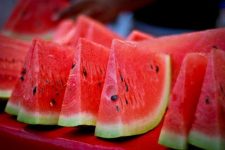Knowing what to look for can making picking a tasty melon much easier
MANHATTAN, Kan. – Picking a ripe melon from the field or grocery store can be challenging. But Kansas State University horticulture expert Ward Upham says it can also be fairly easy if you know what to look for.
“Let’s start with the easy one,” Upham said. “Muskmelons (which include cantaloupe) are one of those crops that tell you when they are ready to be picked.”
As muskmelons ripen, a layer of cells around the stem softens so that the melon detaches easily from the vine. This is called ‘slipping,’ Upham said, and it leaves a dish-shaped scar at the point where the stem attaches to the fruit.
“When harvesting these melons, put a little pressure where the vine attaches to the fruit,” Upham said. “If it is ripe, it will release, or ‘slip.’”
In the produce section, a clean, dish-shaped scar is the best indication that a muskmelon is ripe. “Also, ripe melons have a pleasant, musky aroma if the melons have been held at room temperature,” Upham said.
Picking a ripe watermelon is a little more difficult. Many consumers swear by a “thump” test, or a gentle knock on the outer rind, but there are better ways to determine ripeness, Upham said.
“(In the field), look for the tendril that attaches at the same point as the melon to dry and turn brown,” he said. “On some varieties, this will need to be completely dried before the watermelon is ripe. On others, it will only need to be in the process of turning brown.”
When picking in the field, the surface of the ripening melon develops a roughness (sometimes called sugar bumps) near the base of the fruit. Ripe watermelons normally develop a yellow color on the ground spot – the area of the melon that contacts the ground — when ripe, which is also a good indication for shoppers in the grocery store.
Honeydew melons are the most difficult to tell when they are ripe, Upham said. Except for one variety (Earlidew), “they do not ‘slip’ like muskmelons,” he said.
Instead, “ripe honeydew melons become soft on the flower end of the fruit,” Upham said. “The flower end is the end opposite where the stem attaches.”
When ripe, honeydew will change to a light or yellowish color, though this may vary by variety.
Upham and his colleagues in K-State’s Department of Horticulture and Natural Resources produce a weekly Horticulture Newsletter with tips for maintaining home landscapes. The newsletter is available to view online or can be delivered by email each week.
Interested persons can also send their garden- and yard-related questions to Upham at [email protected], or contact your local K-State Research and Extension office.
FOR PRINT PUBLICATIONS: Links used in this story
K-State Horticulture Newsletter, https://hnr.k-state.edu/extension/info-center/newsletters/index.html
Fact Sheet: Top or Side-Dressing Nitrogen Fertilizer, https://tinyurl.com/j2ggaa6
K-State Research and Extension local offices, www.ksre.k-state.edu/about/stateandareamaps.html
K State Research and Extension is a short name for the Kansas State University Agricultural Experiment Station and Cooperative Extension Service, a program designed to generate and distribute useful knowledge for the well being of Kansans. Supported by county, state, federal and private funds, the program has county extension offices, experiment fields, area extension offices and regional research centers statewide. Its headquarters is on the K State campus in Manhattan. For more information, visit www.ksre.ksu.edu. K-State Research and Extension is an equal opportunity provider and employer.
Story by:
Pat Melgares
785-532-1160
[email protected]
For more information:
Ward Upham
785-532-6173
[email protected]





